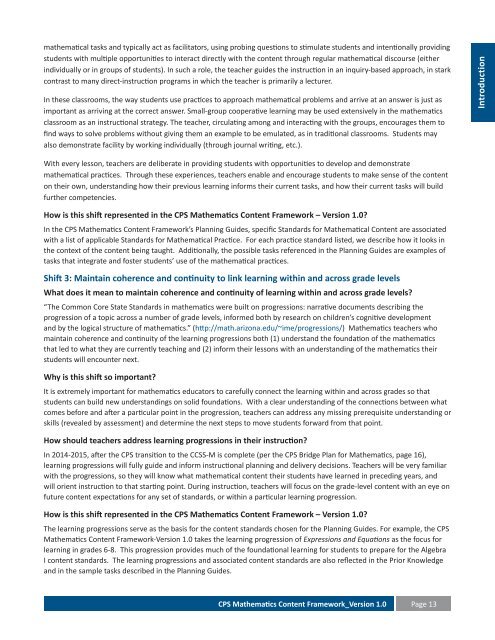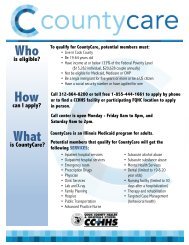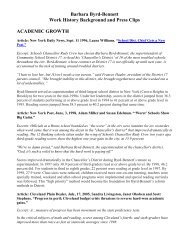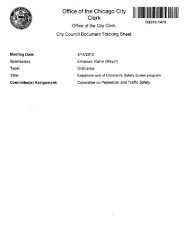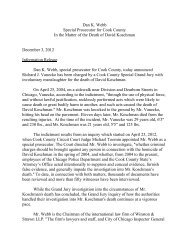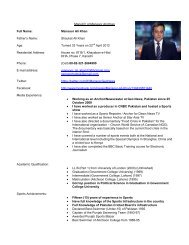Mathematics Content Framework - Chicago Public Schools
Mathematics Content Framework - Chicago Public Schools
Mathematics Content Framework - Chicago Public Schools
You also want an ePaper? Increase the reach of your titles
YUMPU automatically turns print PDFs into web optimized ePapers that Google loves.
mathematical tasks and typically act as facilitators, using probing questions to stimulate students and intentionally providing<br />
students with multiple opportunities to interact directly with the content through regular mathematical discourse (either<br />
individually or in groups of students). In such a role, the teacher guides the instruction in an inquiry-based approach, in stark<br />
contrast to many direct-instruction programs in which the teacher is primarily a lecturer.<br />
In these classrooms, the way students use practices to approach mathematical problems and arrive at an answer is just as<br />
important as arriving at the correct answer. Small-group cooperative learning may be used extensively in the mathematics<br />
classroom as an instructional strategy. The teacher, circulating among and interacting with the groups, encourages them to<br />
find ways to solve problems without giving them an example to be emulated, as in traditional classrooms. Students may<br />
also demonstrate facility by working individually (through journal writing, etc.).<br />
With every lesson, teachers are deliberate in providing students with opportunities to develop and demonstrate<br />
mathematical practices. Through these experiences, teachers enable and encourage students to make sense of the content<br />
on their own, understanding how their previous learning informs their current tasks, and how their current tasks will build<br />
further competencies.<br />
How is this shift represented in the CPS <strong>Mathematics</strong> <strong>Content</strong> <strong>Framework</strong> – Version 1.0?<br />
In the CPS <strong>Mathematics</strong> <strong>Content</strong> <strong>Framework</strong>’s Planning Guides, specific Standards for Mathematical <strong>Content</strong> are associated<br />
with a list of applicable Standards for Mathematical Practice. For each practice standard listed, we describe how it looks in<br />
the context of the content being taught. Additionally, the possible tasks referenced in the Planning Guides are examples of<br />
tasks that integrate and foster students’ use of the mathematical practices.<br />
Shift 3: Maintain coherence and continuity to link learning within and across grade levels<br />
What does it mean to maintain coherence and continuity of learning within and across grade levels?<br />
“The Common Core State Standards in mathematics were built on progressions: narrative documents describing the<br />
progression of a topic across a number of grade levels, informed both by research on children’s cognitive development<br />
and by the logical structure of mathematics.” (http://math.arizona.edu/~ime/progressions/) <strong>Mathematics</strong> teachers who<br />
maintain coherence and continuity of the learning progressions both (1) understand the foundation of the mathematics<br />
that led to what they are currently teaching and (2) inform their lessons with an understanding of the mathematics their<br />
students will encounter next.<br />
Why is this shift so important?<br />
It is extremely important for mathematics educators to carefully connect the learning within and across grades so that<br />
students can build new understandings on solid foundations. With a clear understanding of the connections between what<br />
comes before and after a particular point in the progression, teachers can address any missing prerequisite understanding or<br />
skills (revealed by assessment) and determine the next steps to move students forward from that point.<br />
How should teachers address learning progressions in their instruction?<br />
In 2014-2015, after the CPS transition to the CCSS-M is complete (per the CPS Bridge Plan for <strong>Mathematics</strong>, page 16),<br />
learning progressions will fully guide and inform instructional planning and delivery decisions. Teachers will be very familiar<br />
with the progressions, so they will know what mathematical content their students have learned in preceding years, and<br />
will orient instruction to that starting point. During instruction, teachers will focus on the grade-level content with an eye on<br />
future content expectations for any set of standards, or within a particular learning progression.<br />
How is this shift represented in the CPS <strong>Mathematics</strong> <strong>Content</strong> <strong>Framework</strong> – Version 1.0?<br />
The learning progressions serve as the basis for the content standards chosen for the Planning Guides. For example, the CPS<br />
<strong>Mathematics</strong> <strong>Content</strong> <strong>Framework</strong>-Version 1.0 takes the learning progression of Expressions and Equations as the focus for<br />
learning in grades 6-8. This progression provides much of the foundational learning for students to prepare for the Algebra<br />
I content standards. The learning progressions and associated content standards are also reflected in the Prior Knowledge<br />
and in the sample tasks described in the Planning Guides.<br />
CPS <strong>Mathematics</strong> <strong>Content</strong> <strong>Framework</strong>_Version 1.0 Page 13<br />
Introduction


